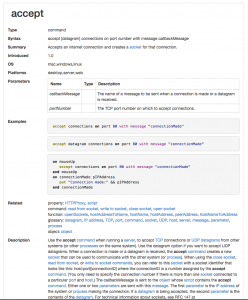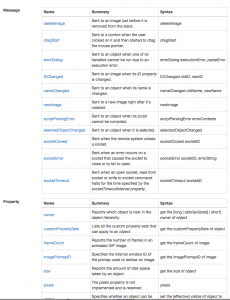Rejected ideas for this blogpost:
a) A meditation on the validity or otherwise of an oft-repeated quote attributed to Dick Brandon on the utility of documentation, whilst delicately avoiding the object of the quote’s comparison.
b) A rehash of Tony Blair’s 2001 speech on education, with the word education replaced everywhere by the word documentation, Labour with LiveCode, etc etc, you see where I’m going with that.
c) An entire blog post written in the style of the documentation format, with some kind of tortured wordplay involving the words “meta” and “documentation” as the title.
Hopefully I made a good decision to reject the above, although as you can see, remnants of those ideas have wormed their way in to this post regardless.
It’s great to hear about various community efforts being organised to improve LiveCode’s User Guide, and translate it into various languages. Here at LiveCode we are continuing to try and find ways to empower our users both in terms of what it’s possible to do with LiveCode, and also ways to contribute to it. Elanor has already written about the user guide in this respect;, and tt would be great if something similar could be done to make it easier to contribute the LiveCode Dictionary.
Currently the dictionary files are in XML, which means they are rather opaquely swathed in tags. Some of these tags are meant to be rendered directly as HTML, while others are merely structural markings. Indeed, some of the older dictionary files contain extremely convoluted passages such as the following:
<description>Use the <b>accept</b> <glossary tag="command">command</glossary> when running a <glossary tag="server">server</glossary>, to accept <glossary tag="TCP">TCP</glossary> connections or <glossary tag="UDP">UDP</glossary> <glossary tag="datagram">datagrams</glossary> from other systems (or other <glossary tag="process">processes</glossary> on the same system).<p>Use the datagram option if you want to accept UDP datagrams.</p><p></p><p><b>Parameters:</b></p><p>The <i>portNumber</i> is the <glossary tag="TCP">TCP</glossary> <glossary tag="port">port</glossary> number on which to accept connections.</p><p>The <i>callbackMessage</i> is the name of a <keyword tag="message box">message</keyword> to be sent when a connection is made or a <glossary tag="datagram">datagram</glossary> is received.</p><p></p><p><b>Comments:</b></p><p>When a connection is made or a datagram is received, the <b>accept</b> <glossary tag="command">command</glossary> creates a new <glossary tag="socket">socket</glossary> that can be used to communicate with the other system (or <glossary tag="process">process</glossary>). When using the <command tag="close socket">close socket</command>, <command tag="read from socket">read from socket</command>, or <command tag="write to socket">write to socket</command> <glossary tag="command">commands</glossary>, you can refer to this <glossary tag="socket">socket</glossary> with a socket identifier that looks like this:</p><p><i>host</i>:<i>port</i>[|<i>connectionID</i>]</p><p>where the <i>connectionID</i> is a number assigned by the <b>accept</b> <glossary tag="command">command</glossary>. (You only need to specify the connection number if there is more than one <glossary tag="socket">socket</glossary> connected to a particular <glossary tag="port">port</glossary> and <glossary tag="disabled">host</glossary>.)</p><p></p><p>The <i>callbackMessage</i> is sent to the <glossary tag="object">object</glossary> whose <property tag="script">script</property> contains the <b>accept</b> <glossary tag="command">command</glossary>. Either one or two <glossary tag="parameter">parameters</glossary> are sent with this <keyword tag="message box">message</keyword>. The first <glossary tag="parameter">parameter</glossary> is the <glossary tag="IP address">IP address</glossary> of the system or <glossary tag="process">process</glossary> making the connection. If a <glossary tag="datagram">datagram</glossary> is being accepted, the second <glossary tag="parameter">parameter</glossary> is the contents of the <glossary tag="datagram">datagram</glossary>.</p><p></p><p>For technical information about sockets, see RFC 147 at <<u>http://www.ietf.org/rfc/rfc147.txt</u>>.</p><p>For technical information about UDP datagrams, see RFC 768 at <<u>http://www.ietf.org/rfc/rfc0768.txt</u>>.</p><p>For technical information about the numbers used to designate standard ports, see the list of port numbers at <<u>http://www.iana.org/assignments/port-numbers</u>><i>,</i> in particular the section entitled "Well Known Port Numbers".</p></description>
…which can’t really be easily understood without, for example, displaying in a browser, or a field using the htmltext property. All of which makes it rather difficult to read and edit, and somewhat fragile too. So I spent some time recently thinking about how we could make dictionary files that are readable, extensible, and easy to adjust. Here is an example of the proposed format, again for the accept command:
Name: accept Type: command Syntax: accept [datagram] connections on port <number> with message <callbackMessage> Summary: Accepts an internet connection and creates a <socket> for that connection. Introduced: 1.0 OS: mac,windows,linux Platforms: desktop,server,web Security: network Example: accept connections on port 80 with message "connectionMade" Example: accept datagram connections on port 80 with message "connectionMade" Example: on mouseUp accept connections on port 80 with message "connectionMade" end mouseUp on connectionMade pIPAddress put "Connection made:" && pIPAddress end connectionMade Parameters: number: callbackMessage: The name of a message to be sent when a connection is made or a datagram is received. portNumber: The TCP port number on which to accept connections. Description: Use the <accept> <command> when running a <server>, to accept <TCP> connections or <UDP> <datagram|datagrams> from other systems (or other <process|processes> on the same system). Use the datagram option if you want to accept UDP datagrams. When a connection is made or a datagram is received, the <accept> <command> creates a new <socket> that can be used to communicate with the other system (or <process>). When using the <close socket>, <read from socket>, or <write to socket> <command|commands>, you can refer to this <socket> with a socket identifier that looks like this: host:port[|connectionID] where the connectionID is a number assigned by the <accept> <command>. (You only need to specify the connection number if there is more than one <socket> connected to a particular <port> and <host>.) The <callbackMessage> is sent to the <object> whose <script> contains the <accept> <command>. Either one or two <parameter|parameters> are sent with this <message>. The first <parameter> is the <IP address> of the system or <process> making the connection. If a <datagram> is being accepted, the second <parameter> is the contents of the <datagram>. For technical information about sockets, see RFC 147 at http://www.ietf.org/rfc/rfc147.txt. For technical information about UDP datagrams, see RFC 768 at http://www.ietf.org/rfc/rfc0768.txt. For technical information about the numbers used to designate standard ports, see the list of port numbers at http://www.iana.org/assignments/port-numbers, in particular the section entitled "Well Known Port Numbers". References: HTTPProxy (property), script (property), read from socket (command), write to socket (command), close socket (command), open socket (command), openSockets (function), hostAddressToName (function), hostName (function), hostAddress (function), peerAddress (function), hostNameToAddress (function), datagram (glossary), IP address (glossary), TCP (glossary), port (glossary), command (glossary), socket (glossary), UDP (glossary), host (glossary), server (glossary), message (glossary), parameter (glossary), process (glossary), object (object) Tags: networking
There are really only two syntactic features of this docs format. The first is element specification, which is just done using a colon, e.g. Name: or Type:. The second is a general linking markup – enclosing text in < and >. Hopefully you’ll agree that the latter is much more legible, and editable to boot. Moreover, it points up an inconsistency in the original file, namely that there is a variable called ‘number’ specified by the syntax, but the associated parameter being described is ‘portNumber’. Converting the xml files into this new format has uncovered all of these inconsistencies.
The idea is that when we are building a new version of LiveCode, these docs files are parsed into an array which can be displayed by the dictionary in a CEF Browser object:
I created a LiveCode highlight.js build, so that we could display LiveCode script in the colours familiar to you from the script editor. You can see the result of that in the code snippets in the above image.
You will also be able to document LiveCode script using exactly the same syntax, and autogenerate an API for it, if for example you are writing a library for distribution. The idea would be that you could add tabs in your dictionary viewer for each of the stacks that is currently being used as a library, as a handy reference tool.
Much of this is in the early stages at the moment, so feedback is very welcome. If this or something like this does become the format of the dictionary files, we’ll immediately be seeking community help to improve our documentation. One of the primary objectives from my point of view would be to improve the examples. There are many examples in the dictionary which refer to not-necessarily-existant objects, or which rely on variables initialised outside of the example. It would be good if, as far as possible, the examples were self contained, and runnable; then they would hopefully be much more useful. I’d also like every parameter of the syntax to have as full a description as possible.
Another important step we are taking is to include a table in every object’s dictionary entry, containing all of the messages and properties associated with that object. Here, for example is a snippet of how the image object’s new entry would look:
Let me know your thoughts in the comments.




14 comments
Join the conversationLiveCode - January 22, 2015
Is Documentation scarier than dating Taylor Swift? Ali investigates: http://t.co/KAv00XrfVd @taylorswift13
gheizhwinder - January 22, 2015
RT @LiveCode: Is Documentation scarier than dating Taylor Swift? Ali investigates: http://t.co/KAv00XrfVd @taylorswift13
William - January 22, 2015
How will this affect back-end development for mobile apps? Will I be able to open ports between iPhones with this? Looking forward to LC 8 and all that it brings!
Ali Lloyd - January 22, 2015
Hi William,
I haven’t looked into to what extent we will be able to implement ‘accept’ functionality on mobile devices in LC8, so I wouldn’t like to say definitively whether what you want to do is possible or not. I just happened to use the accept command as my documentation example as it is alphabetically superior!
In theory though, we should be able to hook into any native APIs, so I don’t see why it wouldn’t be possible.
Ali
Antonielly - January 23, 2015
Rather than developing a new syntax, why don’t you reuse existing, human-readable, standard notations like YAML[http://en.wikipedia.org/wiki/YAML]?
As a bonus, the dictionary refactoring project would make LiveCode incorporate a YAML parser to its official API, to the benefit of all LiveCode users who intend to deal with YAML configuration files in their programs.
Ali Lloyd - January 26, 2015
Hi Antonielly,
YAML does look good, and I don’t think it would require significant changes to tweak the above format so that it conformed. On the other hand, I personally don’t like syntactic whitespace as I fear that introduces a level of complication that might hinder community contribution.
Ultimately we can probably support multiple formats for user documentation. And since we now have all the dictionary data as a single JSON array, it can easily be output in various formats.
Thanks for the suggestion.
Richmond Mathewson - January 24, 2015
I do think your proposed way of doing things is far, far better than XML (and Tony Blair’s speech!), but I also tend to agree with Antonielly insofar as it does seem a bit daft to reinvent the wheel with yet another standard. YAML looks a whole lot simpler than XML as well.
I notice from the Wikipedia article there is a C++ library for YAML . . .
Mark - January 26, 2015
I like it. Much cleaner than XML, displays well, and I do think you could encourage the community to make contributions in this new, simplified format. One thing that would be nice however, is a video introduction to whatever new docs format you come up with; the guided tour 101.
Thanks
MaxV - January 28, 2015
These are my thoughts:
1. I fear translations, I’m not English or American, so I know and image all the problems of translation. A complex programming language like Livecode will arouse a lot of misunderstandings. All big companies gave up to translations, because the technical words must remains the same in all over the world. RunRev company is probably spending too much resource in a no through road. Instead of translation, I would spend money to buy advertising on journals, like libreoffice and other big opensource projects do. People don’t know livecode.
2. Why don’t you use a wiki for documentation? It would speed up corrections and the creation of links between pages/arguments. You could nominee an administrator to accept modifications.
3. table object is a great idea! I like it very much.
BvG - January 30, 2015
How would you implement existing and needed text properties like:
Italics & Bold
Lists (not that they’re formalised right now, but they should be)
Images (Attention, Platform compatibility, etc.)
Subtitles in the description clash with your “:” format (ie. “value:”, “Comments:”, etc.)
I can only agree with other comments about using something existing, because thinking of all possible problems ahead is harder then the backdraws of a slightly over-featured markup. Said that, the easiest to edit for LC users is of course htmltext (LC version). So instead of mediawiki markup or phpbb tags, or any of the other millions of ‘foreign’ ways, why not simply use what everyone already uses daily?
Matt Maier - February 1, 2015
For what it’s worth, I heartily agree that the dictionary needs an update, that it needs to be easier to contribute little nuggets of lessons-learned, and that it just generally should be more complete (like listing all of the associated messages and properties). Having the dictionary automatically include documentation from any libraries you happen to be using would be a sweet bonus.
Additionally, I personally would like a YAML parser. I’m rolling my own extremely limited solution for translating between YAML-formatted text files and Livecode arrays.
Kirk - February 28, 2015
Sounds like a perfect place to use a database – fixed fields, with a self-join to provide a list of commands that can be selected to open detail. It could be delivered on line (MyQSL backend) or as a stand-alone stack (SQL_Lite).
A big nasty XML file, seems to be a convoluted way to handle what is obviously a database solution.
Nick Pulido - March 6, 2015
Hey Ali,
I am very keen to get my hands on that highlight.js syntax file for LiveCode, at the moment I’m using AppleScript but it doesn’t feel as nice as yours looks…Would you be so kind as to point me to where I might find this elusive syntax file, I couldn’t find it on the Git repo. It’s much appreciated, awesome work on the docs -can’t wait to see them in all their CEF glory!
Thanks,
Nick
Ali Lloyd - August 24, 2015
I haven’t yet integrated this into the build system, but here is the link for the file on Git
https://github.com/runrev/livecode-ide/blob/develop/Documentation/html_viewer/js/highlight.pack.js